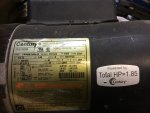- Location
- Chapel Hill, NC
- Occupation
- Retired Electrical Contractor
This pump is for a pool. Apparently it is for 2 speeds but there are many confusing things on this nameplate.
1. How can a motor be rated for 208-230v and why would they not go to 240V.
2. Amps = SF 8.5/1.5 ,... What does that mean? It can't be amps at High and low speed is it. I assume SF is service factor but I never saw a motor amps showing SF
3. Then there is HP.... 1.0 /.12 with a tag after the nameplate that says total HP 1.85 which happens to be the SF also
I don't know how these numbers are gotten. Any help?
This is a friends pool and I have not been there but he replaced the motor 6 weeks ago and it burned up. I am sure they will replace it but should this motor be wired to 240V---actual voltage is 246V

1. How can a motor be rated for 208-230v and why would they not go to 240V.
2. Amps = SF 8.5/1.5 ,... What does that mean? It can't be amps at High and low speed is it. I assume SF is service factor but I never saw a motor amps showing SF
3. Then there is HP.... 1.0 /.12 with a tag after the nameplate that says total HP 1.85 which happens to be the SF also
I don't know how these numbers are gotten. Any help?
This is a friends pool and I have not been there but he replaced the motor 6 weeks ago and it burned up. I am sure they will replace it but should this motor be wired to 240V---actual voltage is 246V



